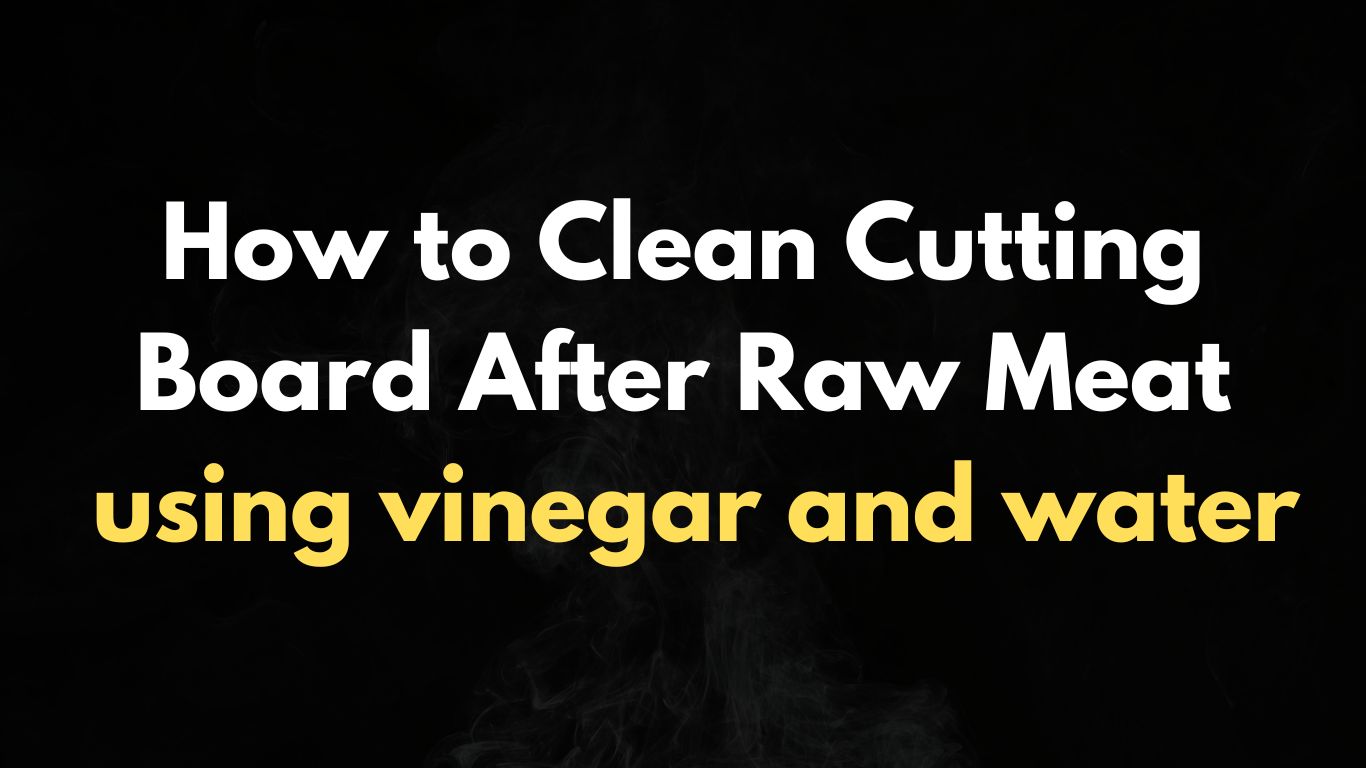We all know the feeling of preparing a delicious meal for family or friends. The fresh ingredients, the chopping, the mixing, and then—raw meat. After using your cutting board for raw meat, it’s easy to just put it aside and move on to the next step in your recipe. But cleaning that board properly is crucial to ensure you’re keeping your kitchen safe from harmful bacteria.
In this step-by-step guide, I’ll show you how to clean cutting board after raw meat. Whether you have a wooden, bamboo, plastic, or olive wood cutting board, these tips and methods will help keep your cutting board in top shape, free from bacteria, and safe for future use.
Let’s dive right in!
Why It’s Important to Clean Your Cutting Board After Raw Meat
Before we jump into the cleaning steps, let’s take a moment to understand why it’s so important to clean your cutting board properly after raw meat. Raw meat, particularly poultry like chicken, can carry harmful bacteria such as Salmonella, E. coli, and Campylobacter. If not cleaned correctly, these bacteria can spread to other foods, leading to potential foodborne illnesses.
According to the Centers for Disease Control and Prevention (CDC), 1 in 6 Americans get sick from foodborne diseases every year. These illnesses can cause serious health problems like stomach cramps, vomiting, diarrhea, and more. That’s why you should always clean your cutting board thoroughly after working with raw meat, especially poultry and red meat.
By following the cleaning steps outlined in this guide, you’re not only keeping your cutting board clean, but you’re also making your kitchen a safer place.
How to Clean Wooden Cutting Board After Raw Meat
Wooden cutting boards are popular for their durability and appearance, but they do require extra care when cleaning. The wood’s porous surface can absorb meat juices, which may harbor bacteria. Here’s how to clean your wooden cutting board after raw meat:
Step 1: Rinse Immediately
As soon as you finish cutting raw meat, rinse the board with warm water. This helps remove any visible residue like blood or juices. If you wait too long, the residue can dry and make cleaning more difficult.
Step 2: Scrub with Dish Soap and Warm Water
Use a small amount of mild dish soap and warm water. Gently scrub the surface of the cutting board with a soft cloth or sponge. Avoid using harsh scrubbing pads that could damage the wood. Pay attention to any grooves or cracks where juices may have settled.
Step 3: Disinfect With Vinegar (Optional)
To make sure your board is sanitized, wipe it down with a mixture of equal parts water and vinegar. Vinegar is a natural disinfectant and helps kill bacteria, so it’s a great addition to your cleaning routine.
Step 4: Dry the Board Thoroughly
After cleaning, dry the wooden cutting board immediately with a clean towel. Moisture can cause the wood to warp or crack, so make sure the board is completely dry.
Step 5: Oil the Board (Optional)
Wooden cutting boards benefit from periodic oiling to keep the wood nourished and protected. You can use food-safe mineral oil or beeswax. I recommend oiling your board once a month to maintain its appearance and prevent it from drying out.
I use my wooden cutting board daily, especially when preparing meat. After cleaning, I always make sure to oil it once a month. It keeps my board looking new and prevents it from cracking, even after years of use!
How to Clean Bamboo Cutting Board After Raw Meat
Bamboo cutting boards are a popular eco-friendly alternative to wooden ones. They’re lightweight, durable, and less prone to damage. However, bamboo cutting boards are also porous and can trap raw meat juices. Here’s how to clean a bamboo cutting board after raw meat:
Step 1: Rinse the Board
Start by rinsing the bamboo cutting board with warm water. This will remove most of the raw meat juices. Be sure not to soak the board for too long, as this can lead to warping.
Step 2: Wash with Dish Soap and Warm Water
Apply mild dish soap to a soft sponge or cloth and scrub the bamboo board gently. Make sure you clean both sides of the board and focus on any grooves or cuts that may have collected meat juices.
Step 3: Disinfect with Vinegar (Optional)
For an extra layer of cleanliness, you can disinfect your bamboo cutting board with a vinegar-water solution. Simply mix one part white vinegar with one part water and wipe it over the surface. Let it sit for a few minutes before rinsing.
Step 4: Dry the Board
Once cleaned, dry the bamboo cutting board immediately with a clean cloth or paper towels. Bamboo is water-resistant, but prolonged exposure to moisture can still cause damage over time.
Step 5: Oil the Board (Optional)
Just like with wooden boards, bamboo cutting boards benefit from periodic oiling. Apply food-safe mineral oil to keep the board smooth and conditioned.
I love using my bamboo cutting board because it’s lightweight and easy to clean. After handling raw meat, I always disinfect it with vinegar and then oil it once a month. It stays in great shape, and I don’t have to worry about it cracking or getting damaged!
How to Clean Plastic Cutting Board After Raw Meat
Plastic cutting boards are common in many kitchens because they’re affordable, easy to maintain, and often dishwasher safe. They don’t absorb meat juices as easily as wood or bamboo, making them easier to clean. However, you still need to clean them thoroughly after raw meat. Here’s how to do it:
Step 1: Rinse with Warm Water
Immediately after using the plastic cutting board, rinse it under warm water to remove any visible residue, such as juices or bits of meat.
Step 2: Scrub with Soap and Warm Water
Apply dish soap to a sponge or cloth and scrub both sides of the plastic cutting board. A plastic board won’t absorb juices, but you still need to clean any visible residue to avoid contamination.
Step 3: Disinfect with Bleach Solution (Optional)
To fully sanitize your plastic cutting board, you can use a bleach solution. Mix 1 tablespoon of bleach with 1 gallon of water, and soak the board for a few minutes. Make sure to rinse it thoroughly afterward.
Step 4: Dry the Board
After washing and disinfecting, dry the plastic cutting board with a clean towel or paper towels. Plastic boards dry quickly, but it’s still important to remove any excess moisture.
I prefer using plastic cutting boards because they’re easy to clean, and I can throw them in the dishwasher. After working with raw meat, I like to disinfect them with a bleach solution to make sure they’re safe to use again.
How to Clean Olive Cutting Board After Raw Meat
Olive wood cutting boards are a beautiful addition to any kitchen. Their unique grain patterns and dense, durable nature make them a favorite among many chefs. However, like wooden and bamboo boards, olive wood is porous and can absorb raw meat juices. Here’s how to clean an olive wood cutting board after raw meat:
Step 1: Rinse the Board
Rinse your olive wood cutting board with warm water immediately after using it. Be sure to remove any leftover meat juices or residue.
Step 2: Wash with Dish Soap and Warm Water
Use a soft cloth or sponge with mild dish soap and warm water to gently clean the surface of the board. Olive wood can be a bit more delicate, so avoid harsh scrubbing.
Step 3: Disinfect with Vinegar (Optional)
For extra sanitization, wipe the olive wood board with a vinegar-water mixture. This will kill bacteria and remove any lingering odors.
Step 4: Dry the Board Thoroughly
After cleaning, dry your olive wood cutting board with a clean towel. Olive wood can crack if exposed to too much moisture, so be sure to dry it properly.
Step 5: Oil the Board
Just like wooden and bamboo boards, olive wood cutting boards need oiling to stay in good shape. Use food-safe mineral oil or beeswax to nourish the wood and prevent it from drying out.
I absolutely love my olive wood cutting board! After working with raw meat, I make sure to disinfect it with vinegar and then give it a good oiling. It’s still in amazing condition, and it looks beautiful every time I use it!
Tips for Maintaining Your Cutting Board
Now that you know how to clean your cutting board after raw meat, let’s talk about some tips to keep your board in great shape for a long time.
- Clean Immediately: Always clean your cutting board right after using it for raw meat. The longer you wait, the harder it will be to remove bacteria and juices.
- Oil Regularly: Wooden, bamboo, and olive wood cutting boards need to be oiled once a month to keep the wood nourished and prevent it from cracking.
- Avoid Soaking: Never soak your cutting board in water for long periods. This can cause the board to warp or crack.
- Sanitize Monthly: Use a vinegar solution or a bleach-water mixture to sanitize your cutting board at least once a month.
- Store Properly: Store your cutting board in a dry area to avoid moisture buildup. Keep it away from direct sunlight or heat sources.
Final Thought: How to Clean Cutting Board After Raw Meat
Keeping your cutting board clean after working with raw meat is essential for maintaining a safe and hygienic kitchen. Whether you have a wooden, bamboo, plastic, or olive wood board, following these simple steps will ensure your board stays clean and your kitchen stays free from harmful bacteria.
By regularly cleaning and maintaining your cutting board, you can ensure that it lasts for years to come and that every meal you prepare is safe for your family and guests. I hope this step-by-step guide has been helpful! If you have any questions or tips of your own, feel free to share them in the comments below. Happy cooking!



